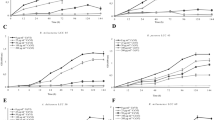Abstract
Three bacterial strains Bacillus pumilis, Cellulosimicrobium cellulans and Exiguobacterium were investigated when grown in Luria-Bertani (LB) medium at 500 μg/mL Cr(VI). The hexavalent chromium reduction was measured by growing the strains in DeLeo and Ehrlich (1994) medium at 200 and 400 μg/mL K2CrO4. The optimal Cr (VI) reduction by strains B. pumilis, Exigubacterium and C. cellulans was 51%, 39%, and 41%, respectively, at an initial K2CrO4 concentration of 200 μg/mL at pH 3 and temperature 37°C. At an initial chromate concentration of 400 μg/mL, the Cr(VI) reduction by strains B. pumilis, Exigubacterium and C. cellulans was 24%, 19%, and 18%, respectively at pH 3 at 37°C after 24 h. These strains have ability to reduce toxic hexavalent chromium to the less mobile trivalent chromium at a wide range of different environmental conditions and can be useful for the treatment of contaminated wastewater and soils.
Similar content being viewed by others
References
Agrafioti E, Kalderis D, Diamadopoulos E. 2014. Arsenic and chromium removal from water using biochars derived from rice husk, organic solid wastes and sewage sludge. J. Environ. Manage., 133: 309–314.
Das A P, Mishra S. 2010. Biodegradation of the metallic carcinogen hexavalent chromium Cr (VI) by an indigenously isolated bacterial strain. J. Carcinog., 9(1): 6, http://dx.doi.org/10.4103/1477-3163.63584.
DeLeo P C, Ehrlich H L. 1994. Reduction of hexavalent chromium by Pseudomonas fluorescens LB 300 in batch and continuous cultures. Appl. Microbiol. Biotechnol., 40: 756–759.
Dhal B, Thatoi H, Das N, Pandey B D. 2010. Reduction of hexavalent chromium by Bacillus sp. isolated from chromite mine soils and characterization of reduced product. J. Chem. Technol. Biotechnol., 85(11): 1471–1479.
Essahale A, Malki M, Marín I, Moumni M. 2012. Hexavalent chromium reduction and accumulation by Acinetobacter AB1 isolated from Fez Tanneries in Morocco. Indian J. Microbiol., 52(1): 48–53.
Faisal M, Hasnain S. 2004. Comparative study of Cr (VI) uptake and reduction in industrial effluent by Ochrobactrum intermedium and Brevibacterium sp. Biotechnol. Lett., 26(21): 1 623–1 628.
Faisal M, Hasnain S. 2006. Growth stimulatory effect of Ochrobactrum intermedium and Bacillus cereus on Vigna radiata plants. Lett. Appl. Microbiol., 43(4): 461–466.
Hameed A, Hasnain S. 2012. Isolation and molecular identification of metal resistant Synechocystis from polluted areas. Afr. J. Microbiol. Res., 6(3): 648–652.
Han X, Wong Y S, Wong M H, Tam N F Y. 2007. Biosorption and bioreduction of Cr(VI) by a microalgal isolate, Chlorella miniata. J. Hazard. Mater., 146(1): 65–72.
Horsfall M J, Arbia A, Spiff A. 2004. Removal of Cu (II) and Zn (II) ions from wastewater by cassava (Manihot esculenta Cranz) waste biomass. Afr. J. Biotechnol., 2(10): 360–364.
Lee S, Lee J-U, Chon H, Lee J. 2008. Reduction of Cr (VI) by indigenous bacteria in Cr-contaminated sediment under aerobic condition. J. Geochem. Explor., 96(2): 144–147.
Loukidou M X, Zouboulis A I, Karapantsios T D, Matis K A. 2004. Equilibrium and kinetic modeling of chromium (VI) biosorption by Aeromonas caviae. Colloid Surfac A, 242(1): 93–104.
Mukherjee K, Nandi R, Saha D, Saha B. 2014. Surfactant-assisted enhancement of bioremediation rate for hexavalent chromium by water extract of Sajina (Moringa oleifera) flower. Desalin. Water Treat, http://dx.doi.org/10.1080/19443994.2014.884477.
Naja G, Mustin C, Volesky B, Berthelin J. 2005. A high-resolution titrator: a new approach to studying binding sites of microbial biosorbents. Water Res., 39(4): 579–588.
Onyancha D, Mavura W, Ngila J C, Ongoma P, Chacha J. 2008. Studies of chromium removal from tannery wastewaters by algae biosorbents, Spirogyra condensate and Rhizoclonium hieroglyphicum. J. Hazard. Mater., 158(2): 605–614.
Pal A, Paul A. 2004. Aerobic chromate reduction by chromium-resistant bacteria isolated from serpentine soil. Microbiol. Res., 159(4): 347–354.
Parameswari E, Lakshmanan A, Thilagavathi T. 2009. Chromate resistance and reduction by bacterial isolates. Aus. J. Basic Appl. Sci., 3(2): 1 363–1 368.
Preetha B, Viruthagiri T. 2005. Biosorption of zinc (II) by Rhizopus arrhizus: equilibrium and kinetic modelling. Afr. J. Biotechnol., 4(6): 506–508.
Romera E, González F, Ballester A, Blázquez M, Munoz J. 2007. Comparative study of biosorption of heavy metals using different types of algae. Bioresource Technol., 98(17): 3 344–3 353.
Tahri Joutey N, Bahafid W, Sayel H, Ananou S, El Ghachtouli N. 2014. Hexavalent chromium removal by a novel Serratia proteamaculans isolated from the bank of Sebou River (Morocco). Environ. Sci. Pollut. Res. Int., 21(4): 3 060–3 072.
Thacker U, Parikh R, Shouche Y, Madamwar D. 2006. Hexavalent chromium reduction by Providencia sp. Process Biochem., 41(6): 1 332–1 337.
Zahoor A, Rehman A. 2009. Isolation of Cr (VI) reducing bacteria from industrial effluents and their potential use in bioremediation of chromium containing wastewater. J. Environ. Sci., 21(6): 814–820.
Zayed A M, Terry N. 2003. Chromium in the environment: factors affecting biological remediation. Plant Soil, 249(1): 139–156.
Zhang K, Li F. 2011. Isolation and characterization of a chromium-resistant bacterium Serratia sp. Cr-10 from a chromate-contaminated site. Appl. Microbiol. Biotechnol., 90(3): 1 163–1 169.
Author information
Authors and Affiliations
Corresponding author
Additional information
Supported by the University of Punjab
Rights and permissions
About this article
Cite this article
Rehman, F., Faisal, M. Toxic hexavalent chromium reduction by Bacillus pumilis, Cellulosimicrobium cellulans and Exiguobacterium . Chin. J. Ocean. Limnol. 33, 585–589 (2015). https://doi.org/10.1007/s00343-015-4155-1
Received:
Accepted:
Published:
Issue Date:
DOI: https://doi.org/10.1007/s00343-015-4155-1




